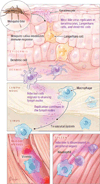West Nile virus: review of the literature
- PMID: 23860989
- PMCID: PMC4563989
- DOI: 10.1001/jama.2013.8042
West Nile virus: review of the literature
Abstract
Importance: Since its introduction in North America in 1999, West Nile virus has produced the 3 largest arboviral neuroinvasive disease outbreaks ever recorded in the United States.
Objective: To review the ecology, virology, epidemiology, clinical characteristics, diagnosis, prevention, and control of West Nile virus, with an emphasis on North America.
Evidence review: PubMed electronic database was searched through February 5, 2013. United States national surveillance data were gathered from the Centers for Disease Control and Prevention.
Findings: West Nile virus is now endemic throughout the contiguous United States, with 16,196 human neuroinvasive disease cases and 1549 deaths reported since 1999. More than 780,000 illnesses have likely occurred. To date, incidence is highest in the Midwest from mid-July to early September. West Nile fever develops in approximately 25% of those infected, varies greatly in clinical severity, and symptoms may be prolonged. Neuroinvasive disease (meningitis, encephalitis, acute flaccid paralysis) develops in less than 1% but carries a fatality rate of approximately 10%. Encephalitis has a highly variable clinical course but often is associated with considerable long-term morbidity. Approximately two-thirds of those with paralysis remain with significant weakness in affected limbs. Diagnosis usually rests on detection of IgM antibody in serum or cerebrospinal fluid. Treatment is supportive; no licensed human vaccine exists. Prevention uses an integrated pest management approach, which focuses on surveillance, elimination of mosquito breeding sites, and larval and adult mosquito management using pesticides to keep mosquito populations low. During outbreaks or impending outbreaks, emphasis shifts to aggressive adult mosquito control to reduce the abundance of infected, biting mosquitoes. Pesticide exposure and adverse human health events following adult mosquito control operations for West Nile virus appear negligible.
Conclusions and relevance: In North America, West Nile virus has and will remain a formidable clinical and public health problem for years to come.
Conflict of interest statement
Figures




Comment in
-
West Nile virus: too important to forget.JAMA. 2013 Jul 17;310(3):267-8. doi: 10.1001/jama.2013.8041. JAMA. 2013. PMID: 23860984 No abstract available.
References
-
- Nash D, Mostashari F, Fine A, et al. The outbreak of West Nile virus infection in the New York City area in 1999. N Engl J Med. 2001;344(24):1807–1814. - PubMed
-
- Zou S, Foster GA, Dodd RY, et al. West Nile fever characteristics among viremic persons identified through blood donor screening. J Infect Dis. 2010;202(9):1354–1361. - PubMed
-
- Pealer LN, Marfin AA, Petersen LR, et al. Transmission of West Nile virus through blood transfusion in the United States in 2002. N Engl J Med. 2003;349(13):1236–1245. - PubMed
Publication types
MeSH terms
Grants and funding
LinkOut - more resources
Full Text Sources
Other Literature Sources
Medical

